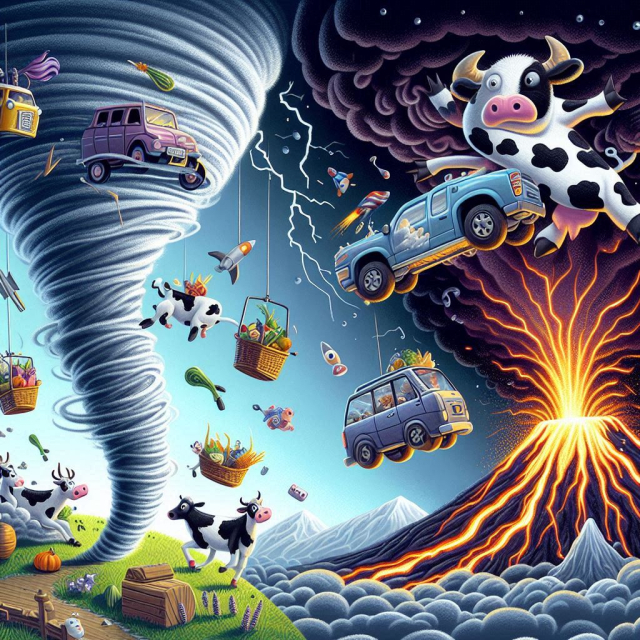Natural disasters are natural phenomena that cause destruction, material damage and significant human loss. These events can occur anywhere in the world and are often unpredictable, adding to their devastating impact. Throughout history, humanity has faced a variety of natural disasters, including earthquakes, hurricanes, floods, volcanic eruptions, tsunamis, and droughts. This article explores the different types of natural disasters, their causes, effects, and the importance of preparation and mitigation to reduce their impact.
Types of natural disasters.
Earthquakes.
Earthquakes are sudden and violent movements of the Earth's crust caused by the release of energy accumulated in the tectonic plates. These movements can cause landslides, tsunamis and massive damage to infrastructure. Earthquakes are unpredictable and can cause large numbers of deaths and injuries. Notable examples include the 2010 Haiti earthquake and the 2011 Fukushima earthquake.
Hurricanes.
Hurricanes, also known as cyclones or typhoons depending on the region, are intense tropical storms that form over warm waters. These phenomena are characterized by strong winds, torrential rains and storm surges. Hurricanes can cause flooding, landslides, and massive property destruction. Some of the most devastating hurricanes in recent history are Hurricane Katrina in 2005 and Hurricane Maria in 2017.
Floods.
Floods occur when there is an overflow of water in normally dry areas, usually due to heavy rain, rapid snowmelt, or failure of structures such as dams. Floods can destroy homes, crops and roads, and cause significant human loss. The floods in Pakistan in 2010 and in Central Europe in 2002 are examples of catastrophic floods.
Volcanic eruptions.
Volcanic eruptions occur when magma, gases and ash rise to the surface through fissures in the Earth's crust. Eruptions can be explosive and destructive, affecting life, property and the environment. The eruption of Mount Vesuvius in 79 AD, which destroyed Pompeii, and the eruption of Mount Saint Helens in 1980 are examples of devastating volcanic eruptions.
Tsunamis.
Tsunamis are large ocean waves generated by underwater earthquakes, volcanic eruptions or landslides. These waves can travel at high speeds and cause massive destruction on coastlines. The 2004 Indian Ocean tsunami and the 2011 Japan tsunami are examples of tsunami disasters.
Droughts.
Droughts are prolonged periods of water shortage due to lack of precipitation. Droughts can cause agricultural losses, drinking water shortages, and economic problems. Droughts in the Horn of Africa and California, United States, have had devastating consequences for affected populations.
Causes of Natural Disasters.
Geological Factors.
Tectonic plate movements, volcanic activity and the topography of the earth are geological factors that can trigger natural disasters such as earthquakes, volcanic eruptions and tsunamis. These factors are beyond human control, but their study and understanding are essential for the prediction and mitigation of disasters.
Climatic factors.
Climate and weather patterns play a crucial role in the occurrence of natural disasters such as hurricanes, floods and droughts. Global warming and climate change are altering these patterns, increasing the frequency and intensity of some natural disasters. Warmer temperatures can intensify hurricanes and prolong droughts.
Human Intervention.
Human intervention, such as deforestation, unplanned urbanization and the construction of infrastructure in risk areas, can aggravate the effects of natural disasters. For example, deforestation can increase the risk of landslides and flooding, while construction in earthquake-prone areas can increase human and material losses.
Effects of Natural Disasters.
Human casualties.
Natural disasters can cause death and injury to thousands of people. The loss of human life is the most tragic effect of these events, and the aftermath can include long-term psychological trauma for survivors.
Destruction of Infrastructures.
Infrastructure, including homes, roads, bridges, and water and power supply systems, can be severely damaged or destroyed during a natural disaster. Rebuilding these infrastructures can take years and requires significant resources.
Economic impact.
Natural disasters can have a devastating economic impact. The destruction of property, the disruption of economic activities, and the cost of rescue and reconstruction operations can significantly impact local and national economies. Developing countries are often the most affected due to lack of resources for recovery.
Environmental impact.
Natural disasters also have a significant impact on the environment. They can destroy natural habitats, cause the death of flora and fauna, and alter ecosystems. Water and soil contamination is another common effect of natural disasters.
Preparation and Mitigation.
Prediction and Early Warning.
Prediction and early warning are essential to reduce the impact of natural disasters. Advanced technologies, such as seismic monitoring systems, weather satellites, and tsunami early warning systems, can help predict and warn communities about impending disasters.
Urban Planning and Resilient Construction.
Proper urban planning and building resilient infrastructure are crucial to mitigate the effects of natural disasters. This includes constructing earthquake-proof buildings, creating effective drainage systems to prevent flooding, and relocating communities away from high-risk areas.
Education and Awareness.
Education and public awareness are essential to prepare communities for natural disasters. First aid training programs, evacuation drills, and awareness campaigns can help people respond effectively during an emergency.
Policies and Legal Framework.
Implementing appropriate policies and legal frameworks is essential for disaster management. Governments must establish regulations for safe construction, natural resource management and emergency response. International cooperation is also vital to confront natural disasters that transcend borders.
Natural disasters are inevitable, but their impact can be reduced through preparation, mitigation and effective response. Understanding the causes and effects of these phenomena, along with the implementation of advanced technologies and appropriate policies, can help protect lives, property and the environment. As climate change continues to alter weather patterns, the need for natural disaster preparedness and resilience becomes increasingly urgent. Global cooperation and continued engagement are essential to meeting the challenges presented by natural disasters in the future.
